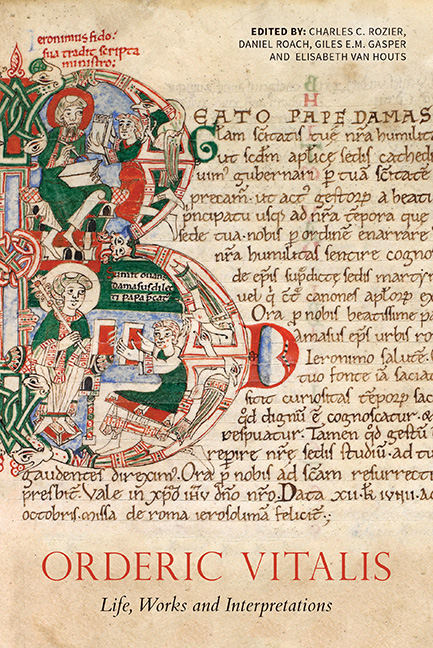Book contents
- Frontmatter
- Dedication
- Contents
- List of Illustrations
- Acknowledgements
- List of Abbreviations
- Chronology of the Lives of Odelerius and his Son Orderic Vitalis
- Composition of the Historia ecclesiastica
- Introduction: Interpreting Orderic Vitalis
- Orderic and his Father, Odelerius
- Following the Master's Lead: The Script of Orderic Vitalis and the Discovery of a New Manuscript (Rouen, BM, 540)
- Orderic Vitalis as Librarian and Cantor of Saint-Évroul
- Saint-Évroul and Southern Italy in Orderic's Historia ecclesiastica
- Orderic and English
- Inscriptions in Orderic's Historia ecclesiastica: A Writing Technique between History and Poetry
- Reading Orderic with Charters in Mind
- Orderic Vitalis and the Cult of Saints
- Orderic's Secular Rulers and Representations of Personality and Power in the Historia ecclesiastica
- Worldly Woe and Heavenly Joy: The Tone of the Historia ecclesiastica
- Orderic Vitalis, Historical Writing and a Theology of Reckoning
- Jesus Christ, a Protagonist of Anglo-Norman History? History and Theology in Orderic Vitalis's Historia ecclesiastica
- ‘Studiosi abdita investigant’: Orderic Vitalis and the Mystical Morals of History
- Meanders, Loops, and Dead Ends: Literary Form and the Common Life in Orderic's Historia ecclesiastica
- Orderic and the Tironensians
- ‘One single letter remained in excess of all his sins …’: Orderic Vitalis and Cultural Memory
- The Reception of Orderic Vitalis in the Later Middle Ages
- Appendix 1 Archaeological Investigations at the Abbey of Saint-Évroult-Notre-Dame-des-Bois
- Appendix 2 Descriptive Catalogue of Manuscripts Featuring the Hand of Orderic Vitalis
- Select Bibliography
- List of Manuscripts Cited
- General Index
Following the Master's Lead: The Script of Orderic Vitalis and the Discovery of a New Manuscript (Rouen, BM, 540)
Published online by Cambridge University Press: 25 October 2017
- Frontmatter
- Dedication
- Contents
- List of Illustrations
- Acknowledgements
- List of Abbreviations
- Chronology of the Lives of Odelerius and his Son Orderic Vitalis
- Composition of the Historia ecclesiastica
- Introduction: Interpreting Orderic Vitalis
- Orderic and his Father, Odelerius
- Following the Master's Lead: The Script of Orderic Vitalis and the Discovery of a New Manuscript (Rouen, BM, 540)
- Orderic Vitalis as Librarian and Cantor of Saint-Évroul
- Saint-Évroul and Southern Italy in Orderic's Historia ecclesiastica
- Orderic and English
- Inscriptions in Orderic's Historia ecclesiastica: A Writing Technique between History and Poetry
- Reading Orderic with Charters in Mind
- Orderic Vitalis and the Cult of Saints
- Orderic's Secular Rulers and Representations of Personality and Power in the Historia ecclesiastica
- Worldly Woe and Heavenly Joy: The Tone of the Historia ecclesiastica
- Orderic Vitalis, Historical Writing and a Theology of Reckoning
- Jesus Christ, a Protagonist of Anglo-Norman History? History and Theology in Orderic Vitalis's Historia ecclesiastica
- ‘Studiosi abdita investigant’: Orderic Vitalis and the Mystical Morals of History
- Meanders, Loops, and Dead Ends: Literary Form and the Common Life in Orderic's Historia ecclesiastica
- Orderic and the Tironensians
- ‘One single letter remained in excess of all his sins …’: Orderic Vitalis and Cultural Memory
- The Reception of Orderic Vitalis in the Later Middle Ages
- Appendix 1 Archaeological Investigations at the Abbey of Saint-Évroult-Notre-Dame-des-Bois
- Appendix 2 Descriptive Catalogue of Manuscripts Featuring the Hand of Orderic Vitalis
- Select Bibliography
- List of Manuscripts Cited
- General Index
Summary
Orderic Vitalis is arguably one of the most famous scribes of the twelfth century. His distinct and somewhat unusual handwriting was first identified by Léopold Delisle and has been traced in seventeen surviving manuscripts. This discussion introduces an eighteenth manuscript to the corpus of books copied by Orderic – Rouen, Bibliothèque municipale 540 (olim U. 148) – recently discovered at the municipal library of Rouen. The manuscript contains two texts by Anselm of Canterbury, De libero arbitrio and De casu diaboli, as well a hagiographical text on the Carolingian saint Opportuna. As this chapter will show, Rouen, BM, 540 was partly copied, rubricated, and corrected by Orderic Vitalis, probably between the years 1100 and 1142. The identification of a previously unclassified manuscript featuring the handwriting of Orderic presents an opportunity to re-evaluate the scribal activities of this famous author and scribe, as well as the books he helped to copy at the abbey of Saint-Évroul in the early twelfth century. As such, the discussion of Orderic's additions to Rouen, BM, 540 will be placed within a wider review of his additions to other surviving manuscripts, and of trends within his various roles in the production and care of books at the monastery of Saint-Évroul.
This discussion begins with a brief description of the new manuscript find, Rouen, BM, 540, including an overview of the manuscript's contents, codicological profile, and the points at which Orderic's handwriting can be found. Using this newly identified manuscript as a primary example, this chapter also examines some of the distinctive qualities of his handwriting by means of a brief palaeographical overview. Despite the unique aspect of his handwriting, there are few resources currently available that specifically address his work as a copyist in the scriptorium of Saint-Évroul. To offset this gap in the current scholarship, this chapter offers a nuanced look at various letter-forms, ligatures, and abbreviations frequently used by Orderic, each accompanied by a visual example. Equipped with a better understanding of his handwriting, the final section considers the often cursory, yet prominent, nature of Orderic's scribal contributions in the books he helped to copy.
- Type
- Chapter
- Information
- Orderic Vitalis: Life, Works and Interpretations , pp. 37 - 60Publisher: Boydell & BrewerPrint publication year: 2016



